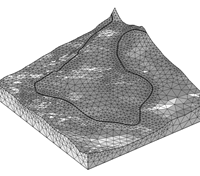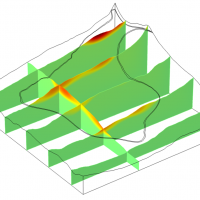Kinematics of slow-moving active landslides
3D Finite element modelling optimized through inverse analysis technique for the analysis of the kinematics of slow-moving active landslides.

We experiment the application of 3D numerical modelling techniques for the analysis of the kinematics of slow-moving active landslides. The activity assesses the hazards posed by slow-moving landslides, determines the factors controlling the slope processes, investigates the potential evolution of the active slopes, and helps selecting appropriate slope mitigation strategies.
We exploit modern numerical modelling techniques based on finite element methods, using two-dimensional (PLAXIS-2D) and three-dimensional (PLAXIS-3D, COMSOL Multiphysics) commercial software. We calibrate and optimize our numerical models using landslide-monitoring data acquired using traditional and new techniques, on the ground, from the air, and from space.
The numerical models can be used to predict the kinematical evolution of the landslides.
Results
The numerical models that we have developed for a number of large landslides in Italy and Spain allowed us to identify the sectors of the slopes affected by large deformations and deformation velocities, to detect the direction and the components (EW, NS) of movements, and to outline subsiding and rising areas.
The models have also allowed us to detect areas subject to shear deformation, where damage to structures and infrastructure is to be expected.
The numerical models allow us to make hypotheses on the evolution of the landslides we have studied.
Granting institutions
- EC FP7 LAMPRE Project
To know more
Calò F, Ardizzone F, Castaldo R, Lollino P, Tizzani P, Guzzetti F, Lanari R, Angeli MG, Pontoni F, Manunta M. 2014. Enhanced landslide investigations through advanced DInSAR techniques: the Ivancich case study, Assisi, Italy. Remote Sensing of Environment 142, 69-82. DOI: 10.1016/j.rse.2013.11.003.
Castaldo R, Tizzani P, Lollino P, Calò F, Ardizzone F, Lanari R, Guzzetti M, Manunta M. 2014. Landslide kinematical analysis through inverse numerical modelling and differential SAR interferometry. Pure and Applied Geophysics. DOI: 10.1007/s00024-014-1008-3.
Manconi A. Lollino P. Duro J. Mondini A. Guzzetti F. 2015. Use of Space-borne InSAR data to Optimize Landslide Numerical Models: the example of an Ancient Landslide in El Portalet, Central Pyrenees, Spain. In Proceedings of FRINGE’15: Advances in the Science and Applications of SAR Interferometry and Sentinel-1 InSAR Workshop, Frascati, Italy, 23-27 March 2015, Ouwehand L., Ed., ESA Publication SP-731. doi:10.5270/Fringe2015.142








 Contact person: piernicola lollino -
Contact person: piernicola lollino -